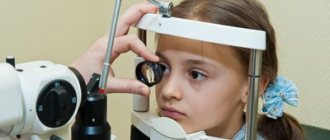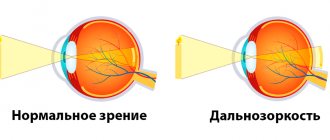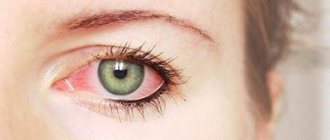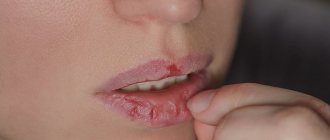Farsightedness in children is a refractive error characterized by abnormal focusing of rays behind the retina rather than on it, which leads to blurred images of nearby objects. According to statistical data, farsightedness occurs in 85% of cases in children under the age of three, and up to 35% in children under the age of twelve. At this age, refraction is determined by the physiological characteristics of the child’s body.
Most children are born farsighted because at that age their eyeball has not yet developed. Hypermetropia in infancy can range from +3 to +3.5 diopters and is the age norm. As the organs of vision grow and develop, optical power changes: the growth of the eyeball leads to a shift in optical focus to the retina, so hypermetropia decreases. Its correction and treatment are required if it does not go away by the age of ten to twelve. If appropriate measures are not taken, disorders such as amblyopia and strabismus may develop.
Why does hypermetropia occur?
Farsightedness occurs due to a difference in the strength of the refractive apparatus and the size of the eye, which, in turn, can be caused by weakness of the apparatus or an abnormally short anteroposterior axis of the eyeball. Both factors lead to the formation of a focus behind the retina. The following causes of hypermetropia in children are distinguished:
- Anatomical congenital features of the structure of the eyes, which cause the lens to be too deep, the axis of the eye not long enough, or a defect in the curvature of the ocular cornea;
- A hereditary predisposition that is passed on from parents if mom, dad, or both of them suffer from farsightedness;
- Increased intraocular pressure – glaucoma;
- Any factors that can negatively affect the fetus and the formation of its visual system during gestation.
Causes
Hyperopia in young children is a natural condition. At this age, the reasons may be physiological:
- short length of the anterior-posterior axis of the eye;
- weak refractive power of the cornea and lens.
But if the parents were diagnosed with farsightedness at one time, then we can assume that the child inherited this disease. You can also identify factors for the congenital development of farsightedness:
- improper nutrition of a woman during pregnancy and lactation;
- unfavorable environment;
- frequent stressful conditions, depression.
If parents observe symptoms of farsightedness in a 3-4 year old child, which can no longer be attributed to age-related physiological characteristics of vision, it is imperative to undergo a full diagnosis by an ophthalmologist and begin timely treatment.
Classification of eye hypermetropia in a child
Classifications of this disease are carried out in accordance with various factors, which, along with the types, types and forms of farsightedness, are presented in our table.
| Types, degrees, forms | Their features |
| Types by development mechanism | |
| Refractive | Pathology develops as a result of diseases of the cornea and eye lens. |
| Axial | The disease develops due to the anatomical features of the eye structure. |
| Forms in accordance with the severity of clinical manifestations | |
| Hidden | Refractive errors are corrected due to increased accommodation of the ciliary muscles, due to which the focus formation occurs correctly, which ensures the desired visual acuity. |
| Explicit | Accommodation is reduced, which manifests itself in difficulties with visual acuity at close distances. |
| Full | There are disturbances of accommodation and refraction. |
| Degrees of hypermetropia in children according to deviation from the norm | |
| Weak | A decrease in vision to two diopters in this case is considered normal and does not require treatment. If it persists at the age of six or seven years, correction may be required. |
| Average | A decrease in vision to five diopters in children over the age of eight is a deviation from the norm and requires correction. |
| Heavy | A decrease in vision of more than five diopters requires systematic correction, since it is manifested by a lack of clarity: both near and far. |
Varieties
Depending on the degree of impairment, farsightedness of the eyes is distinguished:
- weak (less than 3 diopters);
- medium (from 3 to 6 diopters);
- high (more than 6 diopters).
Hypermetropia is also known:
- Natural age. In newborns it is a variant of the norm. Due to the small size of the eyeball, the image is focused behind the retina. Gradually the eyeball enlarges and vision returns to normal.
- Senile age (presbyopia). Over the years, the lens becomes less elastic, and the muscles that hold it in place weaken. As a result, the accommodative ability of the eyes decreases, which provokes refractive error.
According to clinical manifestations, farsightedness is divided into:
- physiological – typical for children, there are no pathologies of the visual organs;
- pathological – characterized by pathological changes;
Symptoms of farsightedness in children
Clinical manifestations of the disease in children directly depend on the degree of the disease. It is important that parents are attentive and pay attention to any oddities in the baby’s behavior.
| Degree of farsightedness | Clinical manifestations |
| Weak |
|
| Average |
|
| Heavy |
|
Etiological factors in the development of childhood farsightedness
The reasons for the development of farsightedness in childhood are:
- genetic factors; malformations of the visual system, incorrect formation of eye structures;
- disturbance of intrauterine growth of the fetus;
- traumatic eye damage from chemical compounds or physical factors;
- conditions after infectious processes;
- operations on the visual organ;
- increased stress, eye fatigue;
- incorrectly selected glasses or contact lenses.
Diagnosis of hypermetropia in children
Before starting treatment of farsightedness in children, specialists conduct comprehensive diagnostic studies that allow them to accurately determine the disease, its form, degree, and features. The Sfera clinic has all the necessary equipment to conduct a comprehensive examination of a small patient. We do:
- Visometry, which involves the use of a standard table to determine visual acuity;
- Skiascopy, through which you can evaluate the refractive characteristics of the eye;
- Scanning the eye using ultrasound;
- Refractometry, which allows you to determine the condition of the eye lens and cornea.
Types of hyperopic astigmatism
In medicine, a classification of the disease is accepted according to the form of refractive error in two perpendicular meridians:
- Simple hypermetropic astigmatism (H) - the distortion passes along one meridian, and in the other the refraction is normal.
- Complex hypermetropic astigmatism of both eyes (CH) – the child’s refraction is distorted along two meridians. In this case, one may have farsightedness, and the other may have myopia or also farsightedness. The child sees a very distorted picture because there is a high degree of refractive power pathology. Retrieved from: https://www.ncbi.nlm.nih.gov/pubmed/24637486 Kulp MT, Ying GS, Huang J, Maguire M, Quinn G, Ciner EB, Cyert LA, Orel-Bixler DA, Moore BD; VIP Study Group Associations between hyperopia and other vision and refractive error characteristics // Optom Vis Sci. 2014 Apr;91(4):383-9. doi: 10.1097/OPX.0000000000000223
How is farsightedness treated in children?
If a child’s hyperopia exceeds the age limit, it is necessary to prescribe glasses or contact correction, as well as hardware treatment in order to form correct vision and prevent the development of strabismus.
For moderate and high hypermetropia, hardware treatment is performed:
- Vacuum massage;
- Laser and magnetic therapy;
- Ultrasound treatment;
- Electrical stimulation.
All procedures are comfortable and require regular treatment, from three to five times a year.
The most effective treatment for hypermetropia is laser correction. However, its implementation is possible only at the age of 18 years, when the formation of the visual apparatus is completed.
Farsightedness and myopia
Some people have both myopia and hypermetropia. A similar situation is usually observed with astigmatism and presbyopia.
If farsightedness is accompanied by a mild form of myopia, then the person feels almost no discomfort. For moderate or high degrees of myopia combined with farsightedness, the doctor recommends using two pairs of glasses: some are used for reading and doing small work, and others are designed to look into the distance. Recently, it has become possible to use only one pair of glasses instead of two pairs - bifocal, progressive or multifocal.
Preventive measures for farsightedness
It is important for parents to understand that farsightedness is a serious pathology that requires professional correction and treatment. If a child is born with a severe degree of this disease, it is necessary to ensure that he is monitored by an experienced specialist.
Preventive measures for hypermetropia consist of following simple rules:
- Regular scheduled examinations with a doctor;
- Active lifestyle, daily walks in the fresh air;
- Proper nutrition providing the body with all the necessary vitamins and microelements;
- Control over the time the child spends at the computer, near the TV or playing games on mobile gadgets;
- Proper organization of the workplace;
- Ensuring high-quality lighting while doing homework;
- Performing gymnastics for the eyes.
Gymnastics for the eyes
Eye gymnastics are often used to prevent rapid visual fatigue in hypermetropia. A small set of movements is performed: rotation of the eyeballs in different directions, frequent squeezing and unclenching of the eyelids, and also focusing on the tip of the nose, and then turning the gaze to a distant object.
If a child has farsightedness, the approach is individual in each case. Make an appointment at our ophthalmology clinic, doctors will conduct a comprehensive examination and prescribe a suitable correction and, if necessary, treatment for complications that have arisen.
Where can hypermetropia be diagnosed and treated?
If you want to be sure that your baby will be in good hands and will receive all the necessary treatment, contact the Sfera clinic. We employ leading domestic specialists, who have everything necessary for accurate diagnosis and effective treatment of farsightedness.
We pay special attention to diagnostics: for this we conduct comprehensive studies that allow us to accurately determine the pathology, its form, degree and characteristics. A treatment plan is drawn up on an individual basis, in accordance with the diagnostic results and the testimony of the little patient.
By contacting us in a timely manner, you can avoid the development of complications in your child and, together with our specialists, you will help him go through the complex process of physical development in the most gentle manner possible.
You can make an appointment with us by filling out the form on the website or by calling.
Lens replacement.
Unfortunately, it is impossible to completely eliminate age-related decline in the quality of vision, since over time the lens inevitably wears out and loses its properties, but a person can delay the onset of presbyopia. To do this, you need to maintain visual hygiene, avoid excessive strain on the eyes, monitor your diet, take vitamins and microelements, and perform visual exercises. Of the hardware techniques, devices that improve the trophism of eye tissue, microcirculation, optic nerve conductivity, methods of accommodation training, and chromotherapy can help delay the development of presbyopia.
Diagnostic methods
After a physical examination, the pediatric ophthalmologist may order the following tests:
- Visometry – determination of visual acuity using a table.
- Ultrasound of the eyeball - contact ultrasound.
- Biomicroscopy is a visual examination of the tissues and optical media of the eye. Based on the contrast between illuminated and unlit areas. Allows you to examine in detail the iris, cornea, lens, anterior chamber of the eye, central areas of the fundus, and vitreous body.
- Skiascopy - the eye is illuminated by a beam of light that is reflected from the mirror, and the doctor observes the movement of shadows in the pupil area.
- Ophthalmoscopy – examination of the fundus of the eye.
- Computer keratotopography - prescribed in difficult cases, involves obtaining a color map of the ocular surface, a hardware-based technique, non-contact and painless.
Home tests
To determine the disease, there are many schematic tests that can be found on the Internet. Some you can do yourself:
- Siemens Star test - a circle with a diameter of 10 cm is displayed on a computer monitor, which is formed from 54 black rays, the background is white, the rays are the same in size and color. The test is carried out in the morning, the brightness of the monitor should be medium. The child takes off his glasses or contacts and moves 5 m away from the screen. First, he closes one eye and looks at the picture for 2-3 seconds, then closes the second eye and looks again for 2-3 seconds. Then you need to look at the picture with both eyes. With astigmatism, the lines visually thicken, bend, their contrast changes, and an oval or shapeless image appears in the center of the circle.
- “Straight Lines” test - with astigmatism, the child sees straight lines drawn or created on a computer as curved.
- Test “Dark lines” - on the monitor you need to draw a circle consisting of straight dark lines, like rays. The child takes the test without taking off his glasses. You need to sit in front of the drawing at a distance of 35 cm, look, closing one eye. All lines should normally be sharp and distinct, equally dark. With astigmatism, some lines are normal, while others are lighter and blurred.
Prevention methods
There are no special ways to prevent hypermetropic astigmatism. It is necessary to protect the eyes from injury and promptly treat diseases of the anterior part of the eye and lens. Regular eye exercises and courses of vitamins to strengthen vision will also be useful. Source: E.P. Tarutta, O.V. Proskurina, N.A. Tarasova, G.A. Markosyan Analysis of risk factors for the development of myopia in preschool and early school age // Health Risk Analysis, 2021, No. 3, pp. 26-31
Sources:
- https://www.ncbi.nlm.nih.gov/pubmed/24637486 Kulp MT, Ying GS, Huang J, Maguire M, Quinn G, Ciner EB, Cyert LA, Orel-Bixler DA, Moore BD; VIP Study Group. Associations between hyperopia and other vision and refractive error characteristics // Optom Vis Sci. 2014 Apr;91(4):383-9. doi: 10.1097/OPX.0000000000000223.
- E.P. Tarutta, O.V. Proskurina, N.A. Tarasova, G.A. Markosyan. Analysis of risk factors for the development of myopia in preschool and early school age // Health Risk Analysis, 2021, No. 3, pp. 26-31.
The information in this article is provided for reference purposes and does not replace advice from a qualified professional. Don't self-medicate! At the first signs of illness, you should consult a doctor.










